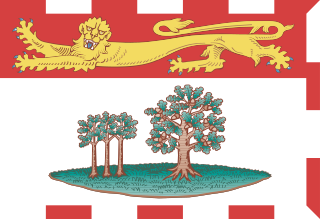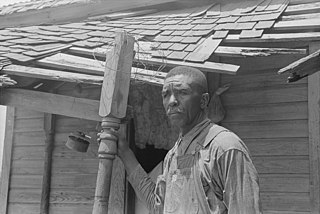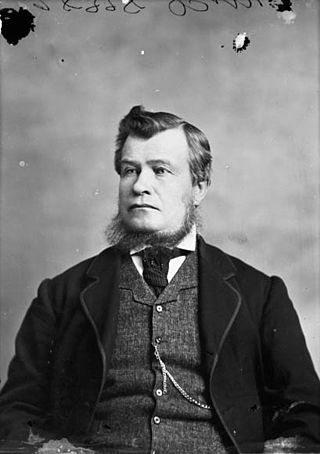
Prince Edward Island is one of the thirteen provinces and territories of Canada. It is the smallest province in terms of land area and population, but the most densely populated. The island has several nicknames: "Garden of the Gulf", "Birthplace of Confederation" and "Cradle of Confederation". Its capital and largest city is Charlottetown. It is one of the three Maritime provinces and one of the four Atlantic provinces.
In economics, an absentee landlord is a person who owns and rents out a profit-earning property, but does not live within the property's local economic region. The term "absentee ownership" was popularised by economist Thorstein Veblen's 1923 book of the same name, Absentee Ownership. Overall, tax policy seems to favour absentee ownership. However, some jurisdictions seek to extract money from absentee owners by taxing land. Absentee ownership has sometimes put the absentee owners at risk of loss.

A tenant farmer is a person who resides on land owned by a landlord. Tenant farming is an agricultural production system in which landowners contribute their land and often a measure of operating capital and management, while tenant farmers contribute their labor along with at times varying amounts of capital and management. Depending on the contract, tenants can make payments to the owner either of a fixed portion of the product, in cash or in a combination. The rights the tenant has over the land, the form, and measures of payment vary across systems. In some systems, the tenant could be evicted at whim ; in others, the landowner and tenant sign a contract for a fixed number of years. In most developed countries today, at least some restrictions are placed on the rights of landlords to evict tenants under normal circumstances.

The Irish National Land League was an Irish political organisation of the late 19th century which sought to help poor tenant farmers. Its primary aim was to abolish landlordism in Ireland and enable tenant farmers to own the land they worked on. The period of the Land League's agitation is known as the Land War. Historian R. F. Foster argues that in the countryside the Land League "reinforced the politicization of rural Catholic nationalist Ireland, partly by defining that identity against urbanization, landlordism, Englishness and—implicitly—Protestantism." Foster adds that about a third of the activists were Catholic priests, and Archbishop Thomas Croke was one of its most influential champions.

James Colledge Pope, was a land proprietor and politician on Prince Edward Island (PEI), Canada. He served as premier of the colony from 1865 to 1867, and from 1870 to 1873. He was premier of PEI in 1873 when the island joined Canadian confederation.
A leasehold estate is an ownership of a temporary right to hold land or property in which a lessee or a tenant holds rights of real property by some form of title from a lessor or landlord. Although a tenant does hold rights to real property, a leasehold estate is typically considered personal property.
Bonshaw is a former rural municipality in the Canadian province of Prince Edward Island within Queens County.
The Land Acts were a series of measures to deal with the question of tenancy contracts and peasant proprietorship of land in Ireland in the nineteenth and twentieth centuries. Five such acts were introduced by the government of the United Kingdom between 1870 and 1909. Further acts were introduced by the governments of the Irish Free State after 1922 and more acts were passed for Northern Ireland.

Kelly v. Sulivan, 1876 CanLII 9, 1 SCR 3 was the first case heard by the Supreme Court of Canada. The Court answered the simple question of whether a case ruling from the Supreme Court of Judicature of Prince Edward Island could be appealed to a provincial appellate court. On the evidence available the Court found that there was insufficient records to prove that an appellate court for the province was ever created.
The Irish Land Commission was created by the British crown in 1843 to 'inquire into the occupation of the land in Ireland. The office of the commission was in Dublin Castle, and the records were, on its conclusion, deposited in the records tower there, from whence they were transferred in 1898 to the Public Record Office'. It took on the role of a rent fixing commission in 1881 via the Land Law (Ireland) Act 1881, also known as the second Irish Land Act. For a century it was the body responsible for re-distributing farmland in most of Ireland. It was formally abolished in 1999.

The Land War was a period of agrarian agitation in rural Ireland that began in 1879. It may refer specifically to the first and most intense period of agitation between 1879 and 1882, or include later outbreaks of agitation that periodically reignited until 1923, especially the 1886–1891 Plan of Campaign and the 1906–1909 Ranch War. The agitation was led by the Irish National Land League and its successors, the Irish National League and the United Irish League, and aimed to secure fair rent, free sale, and fixity of tenure for tenant farmers and ultimately peasant proprietorship of the land they worked.

Walter Patterson was the first British colonial Governor of Prince Edward Island.
The Tenant League in Prince Edward Island was a 19th-century agrarian populist movement whose goal was the "dismantling of the proprietary land system" in that province.

The history of Prince Edward Island covers several historical periods, from the pre-Columbian era to the present day. Prior to the arrival of Europeans, the island formed a part of Mi'kma'ki, the lands of the Mi'kmaq people. The island was first explored by Europeans in the 16th century. The French later laid claim over the entire Maritimes region, including Prince Edward Island in 1604. However, the French did not attempt to settle the island until 1720, with the establishment of the colony of Île Saint-Jean. After peninsular Acadia was captured by the British in 1710, an influx of Acadian migrants moved to areas still under French control, including Île Saint-Jean.
Land Purchase Act is used as a short title and collective title in Prince Edward Island and the United Kingdom for legislation relating to the purchase of land.
Charles Worrell was a lawyer, land owner and political figure in Prince Edward Island. He represented Kings County in the Legislative Assembly of Prince Edward Island from 1812 to 1825. Worrell died in London in 1858.
Land ownership in Canada is held by governments, Indigenous groups, corporations, and individuals. Canada is the second-largest country in the world by area; at 9,093,507 km² or 3,511,085 mi² of land it occupies more than 6% of the Earth's surface. Since Canada uses primarily English-derived common law, the holders of the land actually have land tenure rather than absolute ownership. The Crown is given permission to hold land by treaty granted by the Indigenous people of Canada.

The Land Question, as it pertains to the history of Prince Edward Island, now in Canada, related to the question of the system of ownership of land on the island. Proprietors, the owners of the land parcels on Prince Edward Island, favoured a system of renting to tenants, but the tenants preferred a system of freehold. In 1767, the British government divided all land in Prince Edward Island into lots to be owned by proprietors, who would collect rent from the settlers, or tenants. Problems soon arose with this scheme, and the low numbers of tenants resulted in proprietors collecting little rent, which in turn led to many proprietors defaulting on their quitrents. An attempt at compulsorily acquiring the land by the Prince Edward Island government from rent defaulters in 1781 resulted in Colonial Office intervention in 1783. In 1786, Governor Walter Patterson, who had set in motion the compulsory acquisition, was removed from office.
Agrarian reform and land reform have been a recurring theme of enormous consequence in world history. They are often highly political and have been achieved in many countries.











